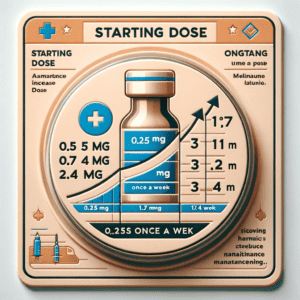
What Is The Best Dosing For Semaglutide?
What Is The Best Dosing For Semaglutide? Semaglutide is a medication that has gained significant attention in the field of diabetes management. It belongs to a class of drugs called glucagon-like peptide-1 receptor agonists (GLP-1 RAs), which work by mimicking the effects of a hormone called glucagon-like peptide-1 (GLP-1) in the body. Semaglutide has been approved by the U.S. Food and Drug Administration (FDA) for the treatment of type 2 diabetes, and it has shown promising results in controlling blood sugar levels and promoting weight loss.
Proper dosage is crucial when it comes to maximizing the benefits of Semaglutide. The right dosage can help control blood sugar levels effectively, reduce the risk of side effects, and optimize the overall management of diabetes. It is important for individuals using Semaglutide to work closely with their healthcare provider to determine the appropriate dosage and make any necessary adjustments along the way.
Understanding Semaglutide: A Brief Overview
Semaglutide is a GLP-1 RA that works by stimulating the release of insulin, a hormone that helps regulate blood sugar levels. It also slows down the emptying of the stomach, which can help reduce appetite and promote weight loss. Semaglutide is administered as a once-weekly injection and is available in different strengths.
The FDA has approved Semaglutide for use in individuals with type 2 diabetes as an adjunct to diet and exercise. It can be used as monotherapy or in combination with other diabetes medications, such as metformin or insulin. Common side effects of Semaglutide include nausea, vomiting, diarrhea, and constipation. These side effects are usually mild and tend to improve over time.
The Role of Semaglutide in Diabetes Management
Semaglutide plays a crucial role in the management of type 2 diabetes by helping to control blood sugar levels. It stimulates the release of insulin from the pancreas, which helps lower blood sugar levels after meals. It also reduces the production of glucagon, a hormone that raises blood sugar levels. By regulating these hormones, Semaglutide helps maintain stable blood sugar levels throughout the day.
In addition to its blood sugar control benefits, Semaglutide has been shown to promote weight loss in individuals with type 2 diabetes. This is particularly beneficial for those who are overweight or obese, as excess weight can contribute to insulin resistance and worsen diabetes control. Semaglutide works by reducing appetite and increasing feelings of fullness, which can lead to reduced calorie intake and weight loss.
Furthermore, Semaglutide has been found to have cardiovascular benefits. In a clinical trial called SUSTAIN-6, Semaglutide was shown to significantly reduce the risk of major adverse cardiovascular events, such as heart attack and stroke, in individuals with type 2 diabetes who were at high risk for cardiovascular disease. This makes Semaglutide a valuable option for individuals with diabetes who also have underlying cardiovascular conditions.
The Importance of Proper Dosage in Maximizing Semaglutide Benefits

What Does Semaglutide Do To Your Body?
Proper dosage is crucial when it comes to maximizing the benefits of Semaglutide. The right dosage can help ensure optimal blood sugar control, promote weight loss, and minimize the risk of side effects. On the other hand, incorrect dosage can lead to inadequate blood sugar control or an increased risk of side effects.
The efficacy and safety of Semaglutide are dose-dependent, meaning that the effects of the medication vary depending on the dosage used. Higher doses of Semaglutide have been shown to provide greater reductions in blood sugar levels and more significant weight loss compared to lower doses. However, higher doses also come with an increased risk of side effects.
It is important for individuals using Semaglutide to work closely with their healthcare provider to determine the appropriate dosage. The healthcare provider will consider factors such as the individual’s age, weight, kidney function, and other medications they may be taking. By taking these factors into account, the healthcare provider can determine the optimal dosage that will provide the maximum benefits with minimal risks.
Factors Affecting Semaglutide Dosage
Several factors can affect the appropriate dosage of Semaglutide for an individual. These factors include age, weight, kidney function, and other medications that the individual may be taking.
Age can influence the metabolism and clearance of Semaglutide from the body. Older individuals may require lower doses of Semaglutide due to changes in their body’s ability to process medications. Weight is another important factor to consider, as higher body weight may require higher doses of Semaglutide to achieve optimal blood sugar control and weight loss.
Kidney function is also a crucial consideration when determining the appropriate dosage of Semaglutide. The kidneys play a role in clearing medications from the body, and individuals with impaired kidney function may require lower doses of Semaglutide to prevent the accumulation of the drug in their system.
Additionally, other medications that an individual is taking can interact with Semaglutide and affect its dosage. For example, certain medications used to treat diabetes, such as insulin or sulfonylureas, can increase the risk of hypoglycemia when combined with Semaglutide. In such cases, the dosage of Semaglutide may need to be adjusted to minimize this risk.
How to Determine the Right Semaglutide Dosage for You
Determining the right dosage of Semaglutide for an individual involves several steps. The initial dosage is typically determined based on the individual’s current diabetes management regimen and their response to previous medications. The healthcare provider will consider factors such as the individual’s blood sugar levels, weight, and overall health.
Here is a table summarizing the standard dosing schedule for Semaglutide:
| Phase | Dosage | Frequency |
|---|---|---|
| Starting Dose | 0.25 mg | Once a week |
| Gradual Increase | 0.5 mg, 1 mg, 1.7 mg, 2.4 mg | Once a week |
| Maintenance Dose | 2.4 mg | Once a week |
This table provides an organized view of how the dosage of Semaglutide is structured, starting from the initial dose, through the gradual increase in dosage, to the maintenance dose. Please note the dosage amounts can vary based on the individual patient’s situation and health profile.
The dosage of semaglutide for weight loss varies depending on individual needs and medical advice. However, a general guideline is as follows:
- Starting Dose: The treatment typically starts with a lower dose of 0.25 mg once a week.
- Gradual Increase: The dosage is gradually increased over weeks to minimize side effects. It usually follows a pattern like 0.5 mg, 1 mg, 1.7 mg, and finally 2.4 mg per week.
- Maintenance Dose: The maintenance dose for weight loss is typically 2.4 mg once a week.
During the titration period, it is important for individuals to monitor their blood sugar levels regularly and report any side effects to their healthcare provider. This allows the healthcare provider to make any necessary adjustments to the dosage and ensure that the individual is receiving the maximum benefits from Semaglutide.
Note: this Semaglutide dosing schedule applies to the following strengths:
- 4 mg/3 mL; 2 mg/1.5 mL (0.25 mg or 0.5 mg dose)
- 2 mg/1.5 mL (1 mg dose)
- 2 mg/3 mL (0.25 mg or 0.5 mg dose)
- 3 mg; mg; 14 mg
- 1 mg/0.5 mL (1 mg dose);
- 0.5 mg/0.5 mL (0.5 mg dose)
- 1.7 mg/0.75 mL (1.7 mg dose)
- 2.4 mg/0.75 mL (2.4 mg dose)
- 0.25 mg/0.5 mL (0.25 mg dose)
- 8 mg/3 mL (2 mg dose)
The Benefits of Starting with a Low Semaglutide Dosage

Generic Semaglutide
Starting with a low dosage of Semaglutide has several benefits. Firstly, it reduces the risk of side effects. Common side effects of Semaglutide, such as nausea and vomiting, are more likely to occur at higher doses. By starting with a low dose and gradually increasing it over time, individuals can minimize these side effects and improve their tolerance to the medication.
Secondly, starting with a low dosage allows for a gradual adjustment to the medication. Semaglutide can have a significant impact on blood sugar levels and appetite, and starting with a low dose gives the body time to adapt to these changes. This can help individuals better manage their diabetes and make necessary lifestyle adjustments, such as changes in diet and exercise habits.
Lastly, starting with a low dosage allows for personalized treatment. Each individual’s response to Semaglutide may vary, and starting with a low dose allows the healthcare provider to tailor the treatment to the individual’s specific needs. By closely monitoring the individual’s response to the medication, the healthcare provider can make any necessary adjustments to the dosage and ensure optimal blood sugar control and weight loss.
Adjusting Semaglutide Dosage: When and How to Do It
What is the best dosing for semaglutide? There are several signs that may indicate the need for a dosage adjustment of Semaglutide. These signs include inadequate blood sugar control, persistent side effects, or changes in weight. If an individual’s blood sugar levels remain elevated despite using Semaglutide, it may be necessary to increase the dosage to achieve better control.
Persistent side effects, such as nausea or vomiting, may also indicate the need for a dosage adjustment. If these side effects are severe or significantly impact the individual’s quality of life, the dosage of Semaglutide may need to be reduced. It is important to communicate any side effects to the healthcare provider so that appropriate adjustments can be made.
Changes in weight can also influence the need for a dosage adjustment. If an individual is not experiencing significant weight loss with Semaglutide, it may be necessary to increase the dosage to achieve the desired effect. On the other hand, if an individual is experiencing excessive weight loss or has reached their weight loss goal, the dosage may need to be reduced to maintain a healthy weight.
When adjusting the dosage of Semaglutide, it is important to do so under the guidance of a healthcare provider. Abrupt changes in dosage can lead to unstable blood sugar levels or an increased risk of side effects. The healthcare provider will determine the appropriate dosage adjustment based on the individual’s response to the medication and their overall health.
The Risks of Incorrect Semaglutide Dosage
Incorrect dosage of Semaglutide can have several risks and complications. One of the main risks is hypoglycemia, or low blood sugar levels. Semaglutide works by stimulating insulin release, and if the dosage is too high, it can lead to excessive insulin production and a drop in blood sugar levels. This can cause symptoms such as dizziness, confusion, sweating, and even loss of consciousness.
Another potential risk of incorrect dosage is gastrointestinal side effects. Semaglutide can cause nausea, vomiting, diarrhea, and constipation, especially at higher doses. If the dosage is too high, these side effects may become more severe and persistent, leading to discomfort and a decreased quality of life.
Other potential risks of incorrect Semaglutide dosage include allergic reactions, pancreatitis (inflammation of the pancreas), and kidney problems. These risks are rare but can occur if the dosage is not properly adjusted or if the medication is used in individuals with certain underlying health conditions. It is important to work closely with a healthcare provider to minimize these risks and ensure the safe and effective use of Semaglutide.
Combining Semaglutide with Other Diabetes Medications: Dosage Considerations

Injectable Weight Loss Medications
When combining Semaglutide with other diabetes medications, dosage considerations become even more important. Certain medications used to treat diabetes can interact with Semaglutide and affect its dosage requirements.
For example, insulin and sulfonylureas are medications that can increase the risk of hypoglycemia when combined with Semaglutide. Insulin helps lower blood sugar levels, and when used in combination with Semaglutide, it can lead to excessive insulin production and a drop in blood sugar levels. Similarly, sulfonylureas stimulate insulin release from the pancreas, and when combined with Semaglutide, they can increase the risk of hypoglycemia.
In such cases, the dosage of Semaglutide may need to be adjusted to minimize the risk of hypoglycemia. The healthcare provider will carefully consider the individual’s current diabetes management regimen and make any necessary adjustments to ensure optimal blood sugar control and minimize the risk of side effects.
Working with Your Healthcare Provider to Optimize Semaglutide Dosage
What is the best dosing for semaglutide? Working closely with a healthcare provider is crucial when it comes to optimizing the dosage of Semaglutide. The healthcare provider has the knowledge and expertise to determine the appropriate dosage based on the individual’s specific needs and health conditions.
It is important to communicate openly with the healthcare provider and provide them with accurate information about your diabetes management, including your blood sugar levels, weight, and any other medications you may be taking. This will help the healthcare provider make informed decisions about the dosage of Semaglutide and any necessary adjustments along the way.
If you have any concerns or questions about your Semaglutide dosage, it is important to discuss them with your healthcare provider. They can provide you with the necessary guidance and support to ensure that you are receiving the maximum benefits from Semaglutide while minimizing any potential risks.
Conclusion of What Is The Best Dosing For Semaglutide?
What is the best dosing for semaglutide?Proper dosage is crucial when it comes to maximizing the benefits of Semaglutide in diabetes management. The right dosage can help control blood sugar levels effectively, promote weight loss, and minimize the risk of side effects. It is important for individuals using Semaglutide to work closely with their healthcare provider to determine the appropriate dosage and make any necessary adjustments along the way.
By considering factors such as age, weight, kidney function, and other medications, the healthcare provider can determine the optimal dosage that will provide the maximum benefits with minimal risks. Starting with a low dosage allows for a gradual adjustment to the medication and reduces the risk of side effects. Regular monitoring of blood sugar levels and side effects is important to ensure that the dosage of Semaglutide is providing the desired effects.
Working with a healthcare provider is essential in optimizing Semaglutide dosage. By maintaining open communication and discussing any concerns or questions, individuals can ensure that they are receiving the most effective and safe treatment for their diabetes. With proper dosage and close monitoring, Semaglutide can be a valuable tool in the management of type 2 diabetes, helping individuals achieve better blood sugar control, weight loss, and overall health.






